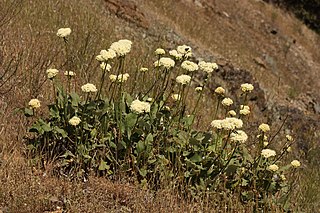
Eriogonum is a genus of flowering plants in the family Polygonaceae. The genus is found in North America and is known as wild buckwheat. This is a highly species-rich genus, and indications are that active speciation is continuing. It includes some common wildflowers such as the California buckwheat.

Eriogonum nudum is a perennial shrub of the wild buckwheat genus which is known by the common name naked buckwheat or nude buckwheat.

Eriogonum fasciculatum is a species of wild buckwheat known by the common names California buckwheat and flat-topped buckwheat. Characterized by small, white and pink flower clusters that give off a cottony effect, this species grows variably from a patchy mat to a wide shrub, with the flowers turning a rusty color after blooming. This plant is of great benefit across its various habitats, providing an important food resource for a diversity of insect and mammal species. It also provides numerous ecosystem services for humans, including erosion control, post-fire mitigation, increases in crop yields when planted in hedgerows, and high habitat restoration value.
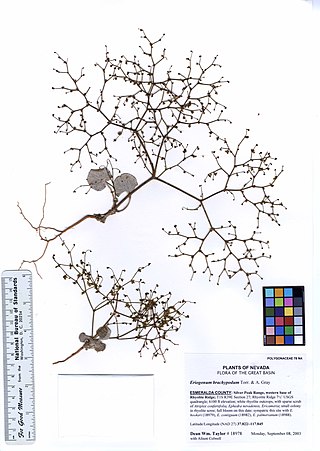
Eriogonum brachypodum is a species of wild buckwheat known by the common name Parry's buckwheat. This annual herb is native to the southwestern United States from California to Utah and especially the Mojave Desert. It grows in sandy and gravelly substrates. It has a skeletonlike spindly stem which branches many times. It can grow 5 to 50 centimeters in height and up to a meter in width. There is an array of rounded, dark-colored leaves around the base. Leaves are a few centimeters long and fuzzy on the undersides. Most of the plant is actually the spreading inflorescence. At intervals on the otherwise naked branches hang tiny clusters of glandular flowers a few millimeters wide in involucres of bell-shaped bracts. Each flower is less than three millimeters wide.

Eriogonum davidsonii is a species of wild buckwheat known by the common name Davidson's buckwheat. This plant is native to the southwestern United States and northern Baja California. It grows in sandy or gravelly soils, mixed grassland, saltbush, chaparral, sagebrush communities as well as oak and montane conifer woodland. It is a spindly annual herb growing up to 40 centimeters in height. Leaves are fuzzy, basal, and round with wavy or wrinkly margins fuzzy. They are two centimeters wide. The plant is variable in appearance, but is usually erect with thin, naked, neatly branching stems bearing clusters of tiny flowers at widely spaced nodes. Each flower is about 2 millimeters wide, bell-shaped, and can be white, pink or red. Flowering occurs May to September.

Eriogonum maculatum is a species of wild buckwheat known by the common name spotted buckwheat. It is native to western North America from Washington to Baja California to Utah, where it can be found in a number of habitats, often in abundance.

Eriogonum nidularium is a species of wild buckwheat known by the common name birdnest buckwheat. It is native to the sandy flats and desert dry washes of the Mojave Desert and Great Basin in the western United States, where it is common and abundant. This is a distinctive annual herb producing a thin, multibranched stem which curves in on itself to form a rounded, tangled mass.

Eriogonum strictum is a species of wild buckwheat known by the common name Blue Mountain buckwheat. It is a common plant of western North America from northern California to British Columbia where it is found along rocky slopes and scrubland. It flowers early in the summer.
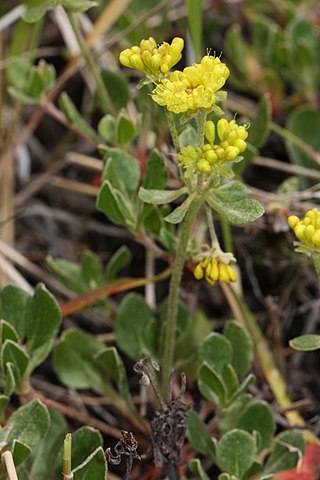
Eriogonum umbellatum is a species of wild buckwheat known by the common name sulphurflower buckwheat, or simply sulphur flower. It is native to western North America from California to Colorado to central Canada, where it is abundant and found in many habitats, including the sagebrush steppe and alpine areas. It is an extremely variable plant and hard to identify because individuals can look very different from one another. Also, there are many varieties. It may be a perennial herb blooming by summer with stems 10 centimeters tall and two to six clusters of flowers, with a whorl of leaves below the stems, or a sprawling shrub approaching two meters high and wide. The leaves are usually woolly and low on the plant, and the flowers come in many colors from white to bright yellow to purple.
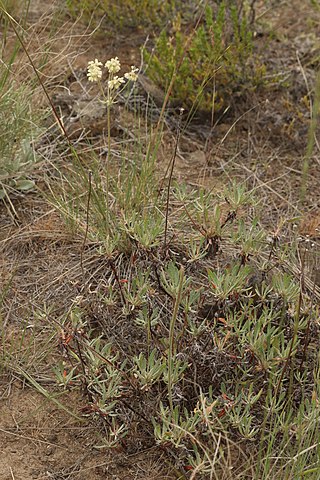
Eriogonum heracleoides is a plant of western North America that has many flowering clusters which are usually cream colored, or off-white. It can usually be found in rocky areas, such as sagebrush deserts and Ponderosa pine forests. Parsnipflower buckwheat is in the genus Eriogonum and the family Polygonaceae, which is a family of plants known as the "knotweed family". It inhabits much of the western part of the United States and southern British Columbia.

Eriogonum ampullaceum is a species of wild buckwheat known by the common name Mono buckwheat.
Eriogonum argillosum is a species of wild buckwheat known by the common names clay buckwheat, clay-loving buckwheat, and Coast Range wild buckwheat. It is endemic to California, where it is known only from San Benito and Monterey Counties. It grows on clay substrates, often of serpentine origin. This is an annual herb up to 30 to 60 centimeters tall with a basal patch of oval-shaped, woolly leaves and a naked stem. The top of the stem is occupied by the inflorescence, a cyme with several clusters of tiny white or pink flowers.

Eriogonum brachyanthum is a species of wild buckwheat that is commonly known as shortflower buckwheat. It is native to eastern California and western Nevada, particularly the Mojave Desert region, where it is common to abundant, and even sometimes weedy. It is also known from southern Oregon. The plant grows in sandy habitats such as desert flats and sagebrush. It also grows in pinyon-juniper and montane conifer woodlands. It is an annual herb that grows 30 to 40 centimeters tall. Leaves are located at the base of the stem, woolly, and oval or rounded in shape. The top of the stem is occupied by a branching inflorescence bearing many widely spaced clusters of flowers. Each individual flower is about a millimeter wide and light yellow in color. Flowers bloom from April to November.

Eriogonum cithariforme is a species of wild buckwheat known by the common name cithara buckwheat.
Eriogonum deserticola is a species of wild buckwheat known by the common name Colorado Desert buckwheat.
Eriogonum pendulum is a rare species of wild buckwheat known by the common name Waldo buckwheat. It is endemic to the Klamath Mountains of Josephine County, Oregon, and Del Norte County, California, where it is a member of the serpentine soils flora.
Eriogonum rixfordii is an uncommon species of wild buckwheat known by the common name pagoda buckwheat. It is native to the Mojave Desert, where it grows in California's Death Valley and adjacent parts of Nevada.

Eriogonum sphaerocephalum is a species of wild buckwheat known by the common names rock buckwheat and round-headed desert buckwheat. It is native to the western United States.

Eriogonum tripodum is a rare species of wild buckwheat known by the common name tripod duckwheat. It is endemic to California, where it is known from the Sierra Nevada foothills and northern sections of the Coast Ranges.
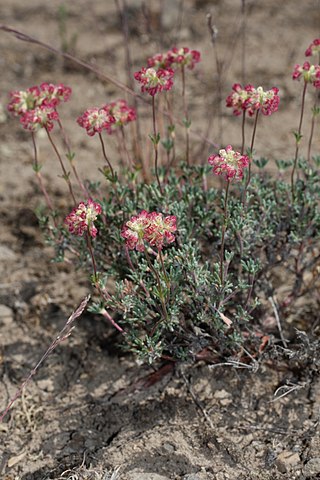
Eriogonum thymoides is a species of flowering plant in the buckwheat family known by the common name thymeleaf wild buckwheat, or simply thymeleaf buckwheat.
















